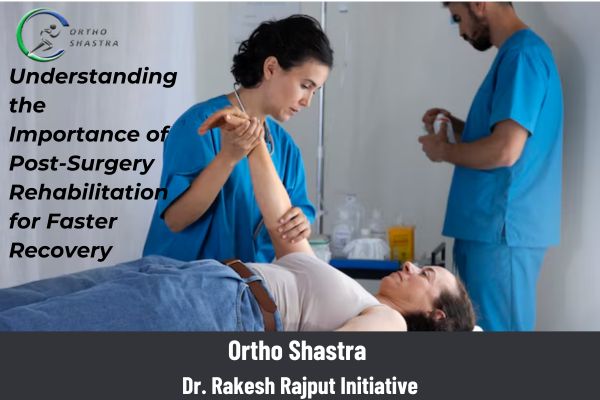Understanding the Importance of Post-Surgery Rehabilitation for Faster Recovery
Post-surgery rehabilitation is a crucial component of the recovery process after joint replacement or orthopedic surgery. While surgery is often necessary to address joint damage, it is the rehabilitation phase that ensures long-term success and helps patients regain full functionality. Here’s why post-surgery rehabilitation is essential for faster recovery:
- Restores Mobility and Strength: After surgery, muscles and joints may become stiff and weak. Physical therapy and rehabilitation exercises are designed to restore movement, improve flexibility, and rebuild strength in the affected area. This helps patients regain their ability to perform daily activities and reduces the risk of complications such as muscle atrophy.
- Reduces Pain and Swelling: Post-surgery rehabilitation often includes techniques like cold therapy, massage, and specific exercises that help reduce pain, swelling, and inflammation. Proper rehabilitation prevents the buildup of scar tissue and minimizes discomfort during the healing process.
- Promotes Proper Healing: Rehabilitation involves gradual and controlled exercises that promote the healing of tissues, ligaments, and muscles surrounding the surgical site. By carefully following a rehabilitation plan, patients can avoid putting undue stress on the healing joint, which can lead to complications and slower recovery.
- Improves Circulation: Movement after surgery helps stimulate blood flow to the affected area, improving circulation and nutrient delivery to the tissues. This is essential for reducing the risk of blood clots and promoting faster healing.
- Prevents Complications: Proper rehabilitation helps prevent common complications like joint stiffness, muscle weakness, and loss of function. By engaging in post-surgery rehabilitation, patients can reduce the likelihood of requiring additional interventions or surgeries in the future.
- Mental and Emotional Support: Recovering from surgery can be mentally and emotionally challenging. Rehabilitation provides structured support, encouraging patients to stay motivated and focused on their goals. Having a professional guide the recovery process can significantly reduce anxiety and boost confidence during rehabilitation.
- Tailored Programs for Individual Needs: Post-surgery rehabilitation is highly personalized. A physical therapist or rehabilitation specialist will assess each patient’s needs, pain levels, and recovery goals to create a tailored program. This ensures that exercises are appropriate and effective, leading to optimal recovery and faster results.
- Ensures Long-Term Success: Proper rehabilitation is essential to ensuring the long-term success of a joint replacement or orthopedic surgery. It helps patients maintain their new joint or repaired area, prevents re-injury, and promotes a higher quality of life post-surgery.
In conclusion, post-surgery rehabilitation plays a vital role in speeding up recovery, reducing pain, restoring mobility, and ensuring that the benefits of the surgery are long-lasting. By following a structured rehabilitation program and working with experienced professionals, patients can significantly improve their chances of a faster and more complete recovery.
“Understanding the Importance of Post-Surgery Rehabilitation for Faster Recovery”
Dr. Rakesh Rajput, a leading orthopedic surgeon, emphasizes the critical role of post-surgery rehabilitation in achieving faster recovery and optimal results following orthopedic surgeries. While surgery addresses the immediate joint or bone issue, rehabilitation ensures long-term success by helping the body heal effectively and restoring mobility. Dr. Rajput advocates for a personalized rehabilitation plan tailored to each patient’s needs to improve healing, reduce pain, and prevent complications.
Key aspects of post-surgery rehabilitation that Dr. Rajput focuses on include:
- Restoring Mobility and Strength: After surgery, the body can become stiff, and muscles may weaken. Dr. Rajput’s rehabilitation approach incorporates targeted exercises to regain movement, flexibility, and strength, helping patients return to daily activities with ease.
- Pain and Swelling Management: Pain and swelling are common after surgery. Dr. Rajput emphasizes the use of techniques such as cold therapy, massage, and specific rehabilitation exercises that reduce discomfort and inflammation, ensuring a smoother recovery.
- Promoting Proper Healing: Post-surgery rehabilitation helps control and guide tissue healing by incorporating exercises that minimize stress on healing joints and muscles, accelerating the recovery process.
- Preventing Complications: Dr. Rajput stresses that rehabilitation minimizes the risk of complications such as joint stiffness, muscle loss, or re-injury. A structured rehab plan aids in keeping patients on track for a full recovery.
- Personalized Rehabilitation Plans: Dr. Rajput works closely with each patient to develop a personalized rehabilitation plan, tailored to their unique condition, goals, and pain tolerance, ensuring the most effective recovery process.
By focusing on these critical components, Dr. Rakesh Rajput helps patients achieve a faster, more efficient recovery after surgery. His holistic approach to post-surgery rehabilitation ensures that patients regain mobility, reduce pain, and prevent long-term complications, leading to improved overall quality of life.

